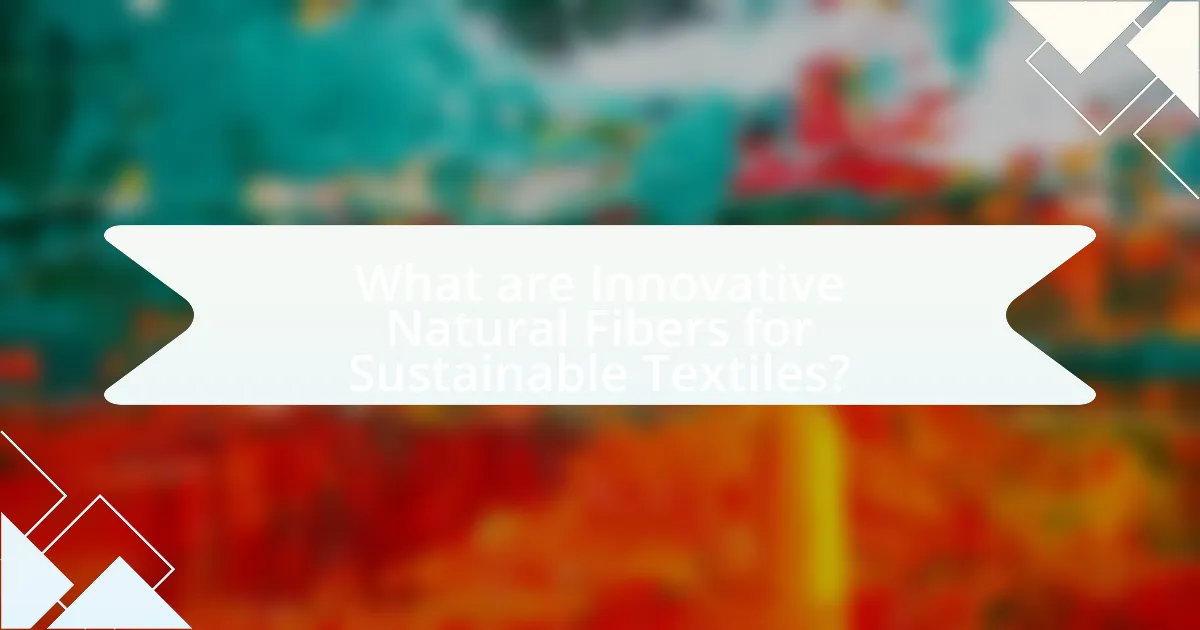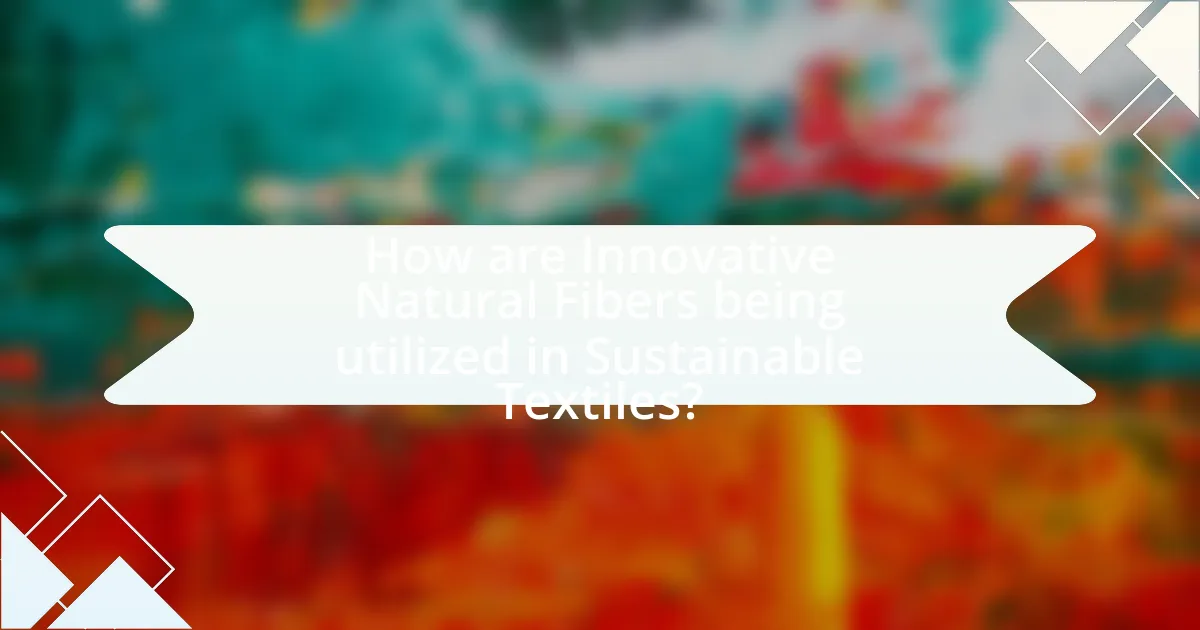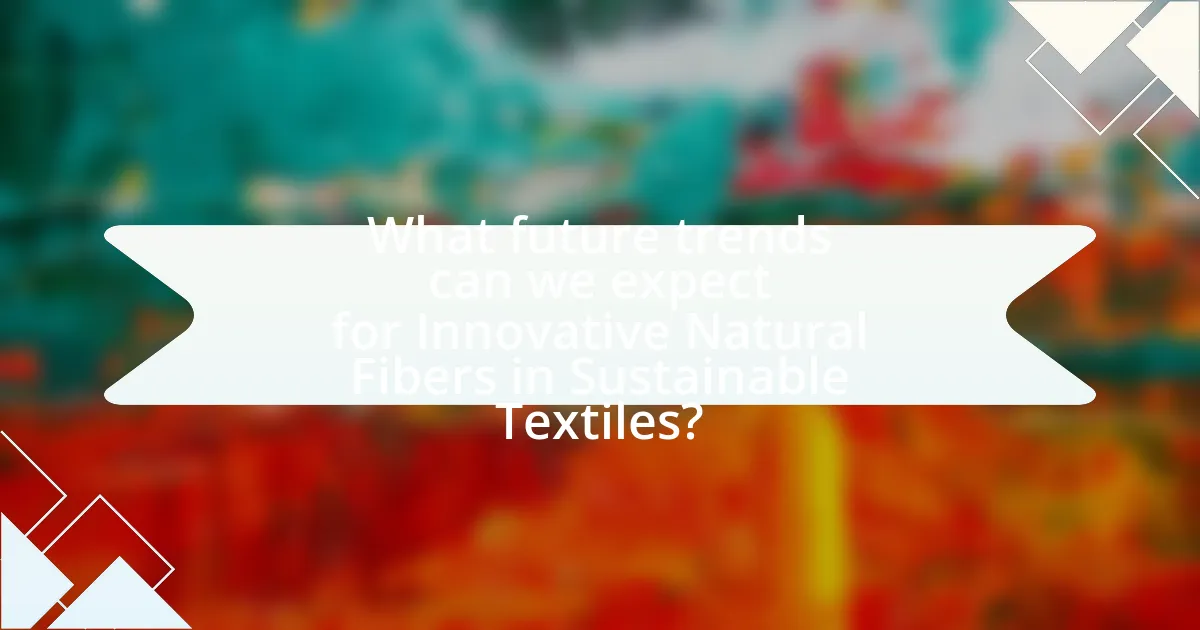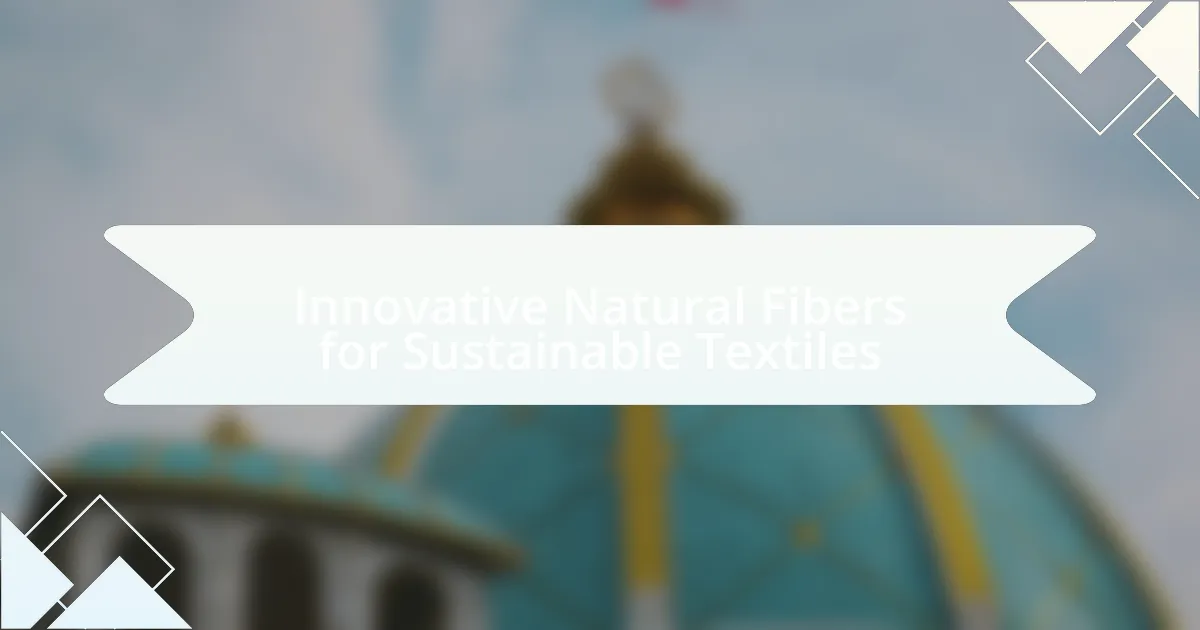Innovative natural fibers for sustainable textiles, including hemp, bamboo, organic cotton, and Tencel, are gaining traction in the textile industry due to their low environmental impact and biodegradability. These fibers differ from traditional options by requiring fewer resources and exhibiting enhanced properties such as durability and moisture-wicking abilities. The article explores the sourcing, processing, and environmental benefits of these fibers, as well as the challenges and consumer responses associated with their use. Additionally, it highlights the role of technology and future trends in advancing the adoption of sustainable textiles, emphasizing the importance of ethical sourcing and consumer education in promoting these eco-friendly materials.

What are Innovative Natural Fibers for Sustainable Textiles?
Innovative natural fibers for sustainable textiles include materials such as hemp, bamboo, organic cotton, and Tencel (lyocell). These fibers are recognized for their low environmental impact, as they are biodegradable and often require fewer resources to produce compared to synthetic fibers. For instance, hemp grows rapidly and can be cultivated without pesticides, while bamboo is known for its ability to thrive in diverse climates with minimal water. Organic cotton is cultivated without harmful chemicals, promoting soil health and reducing water pollution. Tencel, derived from sustainably sourced wood pulp, utilizes a closed-loop production process that recycles water and solvents. These characteristics make these fibers increasingly popular in the textile industry, aligning with the growing demand for eco-friendly and sustainable fashion solutions.
How do innovative natural fibers differ from traditional fibers?
Innovative natural fibers differ from traditional fibers primarily in their enhanced properties and sustainability features. Traditional fibers, such as cotton and wool, have been used for centuries but often involve resource-intensive cultivation and processing methods. In contrast, innovative natural fibers, like those derived from hemp, bamboo, or agricultural waste, are designed to be more environmentally friendly, requiring less water and pesticides, and often utilizing waste materials, which reduces overall environmental impact. For example, hemp can grow in poor soil conditions and requires significantly less water than cotton, making it a more sustainable option. Additionally, innovative fibers often possess improved characteristics such as increased durability, moisture-wicking abilities, and biodegradability, which align with modern consumer demands for sustainable textiles.
What are the key characteristics of innovative natural fibers?
Innovative natural fibers possess several key characteristics that enhance their suitability for sustainable textiles. These fibers are biodegradable, which means they decompose naturally without harming the environment, contributing to sustainability. Additionally, they often have a lower environmental impact during production compared to synthetic fibers, as they typically require less energy and water. Many innovative natural fibers also exhibit unique properties such as moisture-wicking, breathability, and durability, making them functional for various applications. For instance, fibers like hemp and bamboo are known for their strength and resistance to pests, reducing the need for chemical treatments. Furthermore, innovative natural fibers can be sourced from renewable resources, promoting a circular economy in the textile industry.
Why are these fibers considered sustainable?
These fibers are considered sustainable because they are derived from renewable resources and often require less water and chemicals during production compared to conventional fibers. For instance, fibers like organic cotton and hemp can be grown without synthetic pesticides, reducing environmental impact. Additionally, many of these fibers are biodegradable, meaning they break down naturally and do not contribute to long-term waste in landfills. The use of innovative processing techniques further enhances their sustainability by minimizing energy consumption and waste generation.
What role do innovative natural fibers play in the textile industry?
Innovative natural fibers play a crucial role in the textile industry by providing sustainable alternatives to synthetic materials. These fibers, derived from plants, animals, and minerals, contribute to reducing environmental impact through biodegradability and lower carbon footprints. For instance, fibers such as hemp and organic cotton require less water and pesticides compared to conventional cotton, making them more eco-friendly options. Additionally, the use of innovative natural fibers can enhance the performance characteristics of textiles, such as moisture-wicking and breathability, which are increasingly demanded by consumers. The growing trend towards sustainability in fashion has led to a significant increase in the adoption of these fibers, with the global market for sustainable textiles projected to reach $8.25 billion by 2025, according to a report by Allied Market Research.
How are these fibers sourced and processed?
Fibers for sustainable textiles are sourced from various natural materials, including plants, animals, and minerals. Plant fibers, such as cotton and hemp, are harvested from the respective plants, while animal fibers, like wool and silk, are obtained from animals through shearing or harvesting. The processing of these fibers involves several steps: cleaning, carding, spinning, and dyeing. For instance, cotton fibers are separated from seeds, cleaned to remove impurities, and then spun into yarn. This method is supported by the fact that the global cotton industry produced approximately 25 million metric tons in 2021, highlighting the scale of fiber sourcing and processing.
What are the environmental impacts of using innovative natural fibers?
The environmental impacts of using innovative natural fibers include reduced carbon emissions, lower water usage, and decreased reliance on synthetic materials. Innovative natural fibers, such as hemp, bamboo, and organic cotton, are often cultivated with sustainable practices that minimize chemical inputs and promote biodiversity. For instance, hemp requires significantly less water than conventional cotton, using about 50% less, and it can sequester carbon dioxide during its growth, contributing to climate change mitigation. Additionally, the biodegradability of these fibers reduces landfill waste compared to synthetic fibers, which can take hundreds of years to decompose. Studies have shown that transitioning to natural fibers can lead to a 30% reduction in greenhouse gas emissions in the textile industry, highlighting their potential for promoting environmental sustainability.
What challenges are associated with the use of innovative natural fibers?
The challenges associated with the use of innovative natural fibers include variability in fiber quality, limited availability, and processing difficulties. Variability in fiber quality arises from factors such as climate, soil conditions, and cultivation practices, which can lead to inconsistent properties in the final product. Limited availability is often due to the niche nature of many innovative fibers, which may not be produced at scale, impacting supply chains. Additionally, processing difficulties can occur because innovative natural fibers may require specialized techniques or equipment that are not widely accessible, complicating their integration into existing textile manufacturing processes.
How do production costs compare to synthetic fibers?
Production costs for innovative natural fibers are generally higher than those for synthetic fibers. This is primarily due to the labor-intensive processes involved in cultivating, harvesting, and processing natural fibers, which can lead to increased expenses. For example, the production of cotton, a common natural fiber, can cost approximately 30% more than polyester, a widely used synthetic fiber, when considering factors such as agricultural inputs and labor. Additionally, natural fibers often require more complex supply chains and quality control measures, further contributing to their higher production costs compared to synthetic alternatives.
What are the limitations in performance and durability?
Innovative natural fibers for sustainable textiles exhibit limitations in performance and durability primarily due to their inherent properties. For instance, natural fibers like cotton and hemp can be less resistant to moisture and UV degradation compared to synthetic fibers, leading to reduced longevity and performance under harsh environmental conditions. Additionally, natural fibers often have lower tensile strength and can be more susceptible to biological degradation, such as mold and mildew, which can compromise their durability over time. Studies have shown that while natural fibers are biodegradable and environmentally friendly, their mechanical properties may not match those of synthetic alternatives, limiting their application in high-performance textiles.

How are Innovative Natural Fibers being utilized in Sustainable Textiles?
Innovative natural fibers are utilized in sustainable textiles by providing eco-friendly alternatives to synthetic materials, enhancing biodegradability and reducing environmental impact. For instance, fibers such as hemp, bamboo, and organic cotton are increasingly used due to their lower resource consumption and ability to grow without harmful pesticides. Research indicates that hemp requires significantly less water compared to conventional cotton, making it a more sustainable choice. Additionally, advancements in processing techniques have improved the quality and versatility of these fibers, allowing them to be blended with other materials for enhanced performance while maintaining sustainability.
What types of innovative natural fibers are currently in use?
Innovative natural fibers currently in use include hemp, bamboo, organic cotton, and Tencel (lyocell). Hemp is recognized for its strength and biodegradability, making it a sustainable choice for textiles. Bamboo fibers are valued for their softness and antibacterial properties, while organic cotton is cultivated without harmful pesticides, promoting environmental health. Tencel, derived from sustainably sourced wood pulp, is known for its moisture-wicking and biodegradable characteristics. These fibers contribute to sustainable textile production by reducing environmental impact and enhancing the lifecycle of fabric materials.
What are the properties of hemp as a sustainable fiber?
Hemp possesses several properties that make it an excellent sustainable fiber. It is highly durable, with a tensile strength greater than that of cotton, which allows it to withstand wear and tear effectively. Hemp also has natural resistance to pests and diseases, reducing the need for chemical pesticides during cultivation. Additionally, hemp requires significantly less water compared to cotton, making it a more water-efficient crop. The fiber is biodegradable, contributing to environmental sustainability by breaking down naturally without harming ecosystems. Furthermore, hemp cultivation improves soil health through its deep root system, which prevents erosion and enhances nutrient cycling. These properties collectively position hemp as a leading choice for sustainable textiles.
How does bamboo fiber contribute to sustainability?
Bamboo fiber contributes to sustainability by being a renewable resource that grows rapidly without the need for pesticides or fertilizers. This plant can reach maturity in three to five years, significantly faster than traditional trees used for fiber production, which can take decades. Additionally, bamboo absorbs more carbon dioxide and releases more oxygen than many other plants, helping to mitigate climate change. Its cultivation also improves soil health and prevents erosion, making it an environmentally friendly choice for textile production.
How are brands incorporating these fibers into their products?
Brands are incorporating innovative natural fibers into their products by integrating materials such as hemp, organic cotton, and Tencel into their textile lines. For instance, companies like Patagonia utilize hemp for its durability and low environmental impact, while brands like Eileen Fisher focus on organic cotton to promote sustainable farming practices. Additionally, Tencel, derived from sustainably sourced wood pulp, is being adopted by various fashion labels for its biodegradable properties and soft texture. These practices not only enhance product sustainability but also align with consumer demand for eco-friendly options, as evidenced by a growing market trend towards sustainable textiles, which is projected to reach $8.25 billion by 2025.
What are some examples of successful sustainable textile brands?
Some examples of successful sustainable textile brands include Patagonia, Eileen Fisher, and Stella McCartney. Patagonia is known for its commitment to environmental responsibility, using recycled materials and promoting fair labor practices. Eileen Fisher focuses on organic and sustainable fibers, emphasizing transparency in its supply chain. Stella McCartney is recognized for its luxury fashion that avoids animal products and uses eco-friendly materials, setting a standard in the high-end market for sustainability. These brands demonstrate a successful integration of sustainable practices in the textile industry.
How do consumers respond to products made from innovative natural fibers?
Consumers generally respond positively to products made from innovative natural fibers, valuing their sustainability and eco-friendliness. Research indicates that 66% of global consumers are willing to pay more for sustainable brands, reflecting a growing preference for environmentally responsible products. Additionally, innovative natural fibers, such as hemp and Tencel, are often perceived as high-quality alternatives to synthetic materials, enhancing consumer appeal. This positive response is further supported by the increasing awareness of environmental issues and the desire for sustainable fashion choices among consumers.

What future trends can we expect for Innovative Natural Fibers in Sustainable Textiles?
Future trends for innovative natural fibers in sustainable textiles include increased use of bio-based materials, advancements in fiber processing technologies, and a focus on circular economy practices. The shift towards bio-based materials is driven by consumer demand for eco-friendly products, with fibers such as hemp, bamboo, and organic cotton gaining popularity due to their lower environmental impact compared to conventional fibers. Advancements in processing technologies, such as enzymatic treatments and sustainable dyeing methods, enhance the performance and aesthetic qualities of these fibers while reducing water and chemical usage. Additionally, the integration of circular economy principles, including recycling and upcycling of natural fibers, is expected to grow, promoting sustainability and reducing waste in the textile industry. These trends are supported by industry reports indicating a projected growth in the sustainable textiles market, which is expected to reach $8.25 billion by 2027, reflecting the increasing adoption of innovative natural fibers.
How is technology advancing the use of natural fibers?
Technology is advancing the use of natural fibers through innovations in processing, treatment, and application methods. For instance, advancements in biotechnology enable the development of stronger and more durable natural fibers by enhancing their structural properties at the molecular level. Additionally, techniques such as 3D printing and digital weaving allow for more efficient and precise use of natural fibers in textile production, reducing waste and improving sustainability. Research has shown that these technological advancements can increase the performance of natural fibers, making them more competitive with synthetic alternatives, as evidenced by studies highlighting the improved tensile strength and moisture-wicking properties of treated natural fibers.
What innovations are being developed in fiber processing?
Innovations in fiber processing include advancements in enzymatic treatments, which enhance the properties of natural fibers while reducing environmental impact. For instance, researchers are developing enzyme-based methods to improve the strength and durability of fibers like hemp and flax, making them more suitable for sustainable textiles. Additionally, technologies such as bio-based polymers and nanofiber production are being explored to create lightweight, high-performance materials from natural sources. These innovations are supported by studies indicating that enzymatic processing can reduce water and energy consumption by up to 50% compared to traditional methods, thereby promoting sustainability in the textile industry.
How might consumer preferences shape the future of these fibers?
Consumer preferences will significantly shape the future of innovative natural fibers for sustainable textiles by driving demand for eco-friendly and ethically produced materials. As awareness of environmental issues increases, consumers are increasingly favoring products made from sustainable fibers such as organic cotton, hemp, and Tencel, which are perceived as less harmful to the planet. According to a 2021 survey by McKinsey, 67% of consumers consider sustainability when making a purchase, indicating a strong market shift towards sustainable options. This growing preference will encourage manufacturers to invest in the development and production of these fibers, leading to advancements in technology and processes that enhance their sustainability and performance.
What best practices should brands follow when using innovative natural fibers?
Brands should prioritize sourcing innovative natural fibers from sustainable and ethical suppliers. This practice ensures that the fibers are produced with minimal environmental impact and fair labor conditions. Additionally, brands should invest in research and development to explore the unique properties of these fibers, such as biodegradability and durability, which can enhance product performance and appeal. Implementing transparent supply chains is also crucial, as it builds consumer trust and allows for traceability of the materials used. Furthermore, brands should engage in consumer education about the benefits of innovative natural fibers, promoting their environmental advantages over synthetic alternatives. This approach not only supports brand loyalty but also encourages responsible consumer behavior.
How can brands ensure the sustainability of their supply chains?
Brands can ensure the sustainability of their supply chains by implementing transparent sourcing practices and utilizing eco-friendly materials. Transparency allows brands to trace the origins of their materials, ensuring they are sourced from sustainable and ethical suppliers. For instance, brands can adopt certifications such as Fair Trade or Global Organic Textile Standard (GOTS), which verify that materials meet specific environmental and social criteria. Additionally, integrating innovative natural fibers, such as organic cotton or hemp, reduces environmental impact due to their lower resource requirements compared to conventional fibers. Research indicates that organic cotton uses 91% less water than conventional cotton, highlighting the benefits of sustainable material choices. By prioritizing these practices, brands can significantly enhance the sustainability of their supply chains.
What strategies can be employed to educate consumers about these fibers?
To educate consumers about innovative natural fibers for sustainable textiles, brands can implement targeted educational campaigns that utilize digital platforms, workshops, and collaborations with influencers. Digital platforms, such as social media and websites, can disseminate informative content, including videos and infographics, that highlight the benefits and uses of these fibers. Workshops can provide hands-on experiences, allowing consumers to engage directly with the materials and understand their properties. Collaborating with influencers who advocate for sustainability can amplify the message, reaching a broader audience and enhancing credibility. Research indicates that consumers are more likely to trust information from familiar figures, making influencer partnerships effective in promoting awareness and understanding of sustainable fibers.

Leave a Reply